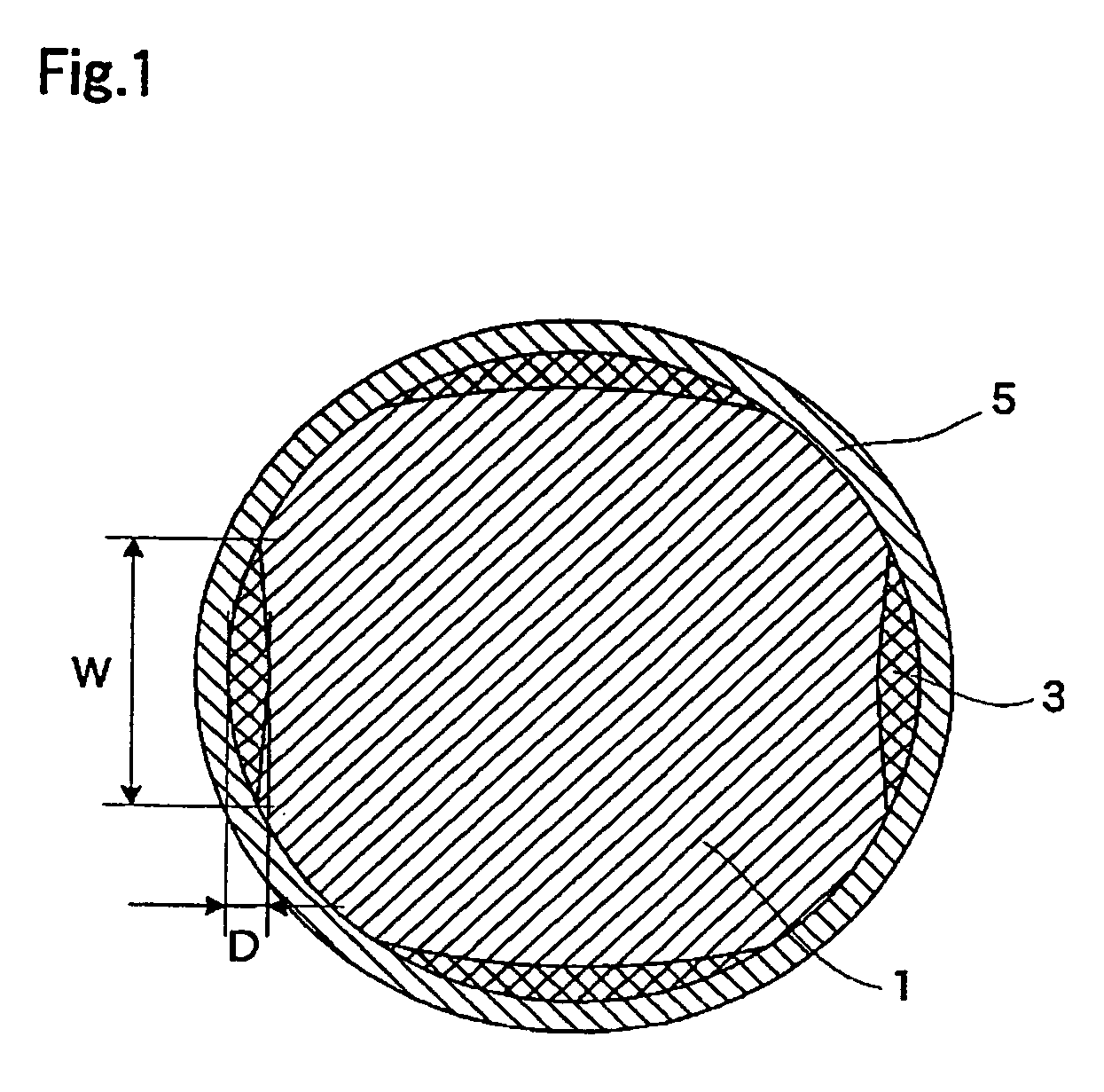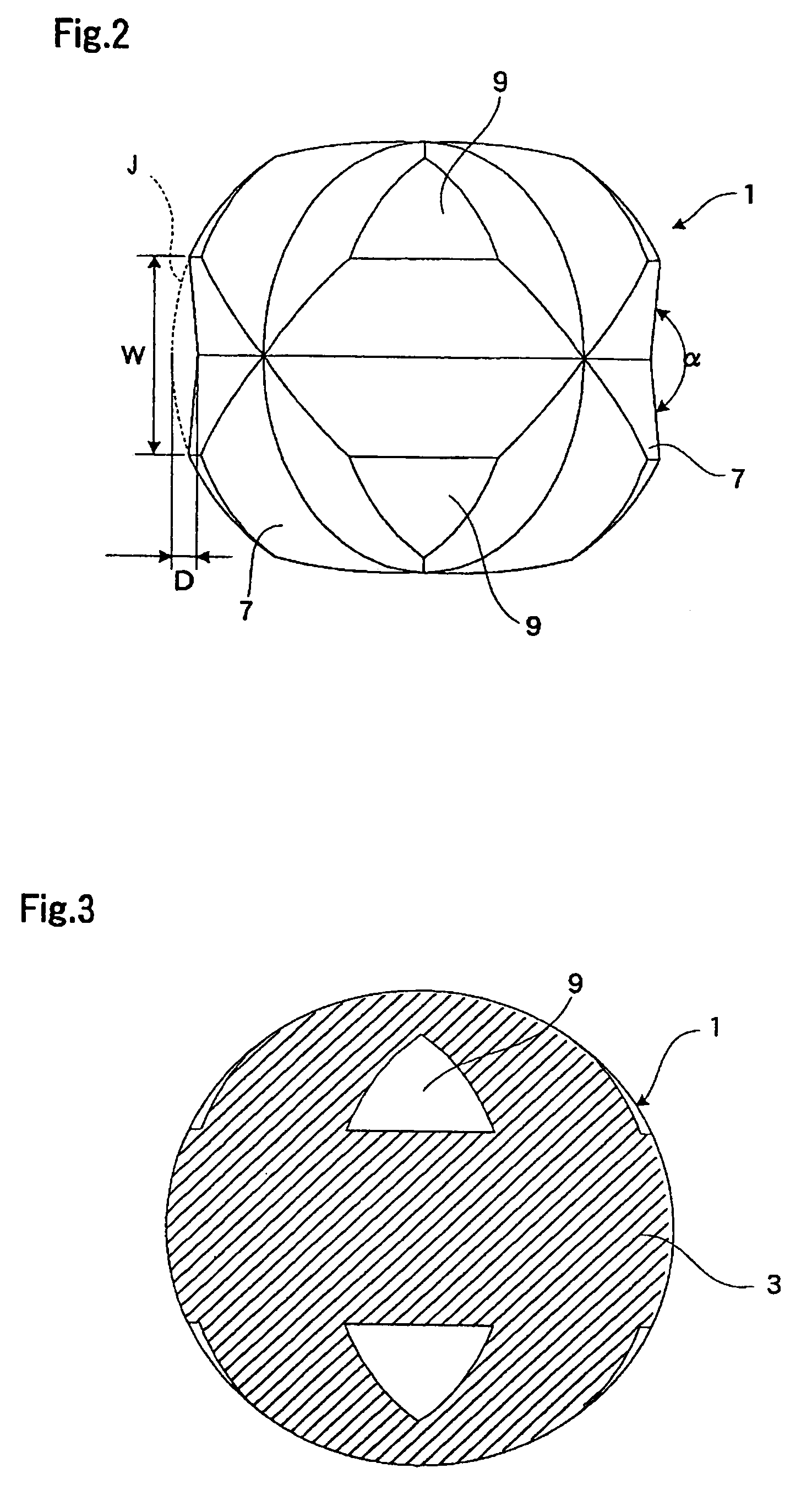Golf ball and mold for manufacturing core thereof
a golf ball and mold technology, applied in the field of golf balls and molds for manufacturing core thereof, can solve the problems of uneven hardness, hard impact feel, and inability to obtain uniform impact feel, and achieve the effect of soft impact feel and high ball resilien
- Summary
- Abstract
- Description
- Claims
- Application Information
AI Technical Summary
Benefits of technology
Problems solved by technology
Method used
Image
Examples
first embodiment
(First Embodiment)
[0027]Hereunder, a golf ball of a first embodiment of the present invention is explained. FIG. 1 is a cross-sectional view of a golf ball of the present invention.
[0028]As shown in FIG. 1, the golf ball of the present embodiment is a so-called three-piece golf ball comprising a core 1, an intermediate layer 3, and a cover 5 covering the core 1 and the intermediate layer 3. According to the rules (see R&A and USGA), the diameter of a golf ball should be no smaller than 42.67 mm. However, taking aerodynamic characteristics and the like into consideration, it is preferable that the diameter of the ball be as small as possible. Therefore, it can be, for example, 42.7 mm.
[0029]FIG. 2 is a front view of the core. The core 1 is spherically shaped as shown in the figure, and is composed of a rubber composition. It is preferable that the maximum diameter of the core 1 be in the range of from 37.5 to 40.5 mm, and more preferably from 38.7 to 39.5 mm. This is because, when th...
second embodiment
(Second Embodiment)
[0044]Hereunder, a golf ball of a second embodiment of the present invention is explained below with reference to drawings. The golf ball of the present embodiment is, as with the first embodiment, a three-piece golf ball; however, the shapes of the core and the intermediate layer covering the core are different from those of the first embodiment.
[0045]The shape of the core is defined as follows: As shown in FIG. 4, three great circles C intersecting each other at right angles are drawn on the surface of a datum sphere E and bands B extend along the great circles C are defined. Here, each region surrounded by bands B is defined as a first surface S1. Each first surface S1 is formed into a triangular shape by three arcs of the same length. Subsequently, as shown in FIG. 5, twelve second surfaces S2 are defined in the portions corresponding to those of the bands B. Each second surface S2 extends between intersections of the great circles C and has a radius of curvat...
examples
[0058]Hereunder, Examples and Comparative Examples of the present invention are described. With regard to two-piece golf balls, eleven types golf balls of the present invention (Examples 1 to 11) and two other types of golf balls (Comparative Examples 1 to 2) were prepared. The golf balls of Examples 1 to 11 and Comparative Examples 1 to 2 comprise a core, an intermediate layer and a cover formed from the materials having the constituents shown in Tables 1 and 2 below. Specifically, four different materials a to d for which the ratios of constituents are shown in Table 1 were used for manufacturing the core. Five different materials A to E as shown in Table 2 were used for manufacturing the intermediate layer and cover.
[0059]
TABLE 1Parts by weightabcdBR-11 (manufactured100100100100by JSR Corporation)Zinc acrylate26263636Zinc oxide5555Barium sulfate241052Dicumyl peroxide1111Antioxidant0.10.10.10.1Shore D hardness45455454
[0060]
TABLE 2intermediate layer and cover>Parts byShore DTypeMat...
PUM
 Login to View More
Login to View More Abstract
Description
Claims
Application Information
 Login to View More
Login to View More - R&D
- Intellectual Property
- Life Sciences
- Materials
- Tech Scout
- Unparalleled Data Quality
- Higher Quality Content
- 60% Fewer Hallucinations
Browse by: Latest US Patents, China's latest patents, Technical Efficacy Thesaurus, Application Domain, Technology Topic, Popular Technical Reports.
© 2025 PatSnap. All rights reserved.Legal|Privacy policy|Modern Slavery Act Transparency Statement|Sitemap|About US| Contact US: help@patsnap.com



